Broken Link Building Strategies
Do you ever feel like you’re doing all the right things for SEO, but not seeing the organic traffic you deserve?
There’s a strategy out there you may not have considered. It flies under the radar but can still land you high-authority backlinks without creating brand new content: broken link building.
There are thousands of broken backlinks out there that point to dead pages. It’s wasted link equity waiting for someone to claim it. Why shouldn’t that be you?
In this guide, I’ll show you exactly where and how to find broken links, pitch your content as a replacement, and boost your rankings and domain authority with content you’ve already written or made. It’s a low-effort, high-upside link strategy worth your time.
Broken link building is finding dead links on other sites and suggesting your content as a replacement. It’s one of the smartest ways to build high-quality backlinks without creating content from scratch. You can reap the benefits by earning a link because you’re helping site owners fix their user experience issues.
Links can go bad for a variety of reasons. Maybe the original page was deleted, or a website changed its site structure. Sometimes, the URL might be wrong, or the domain ceases to exist completely. Whatever the cause, a broken link equals a poor user experience (and lost SEO value).
That’s where you come in.
Fixing these links by offering relevant, helpful content improves the referring site’s authority and boosts your rankings and traffic. It’s a win-win opportunity and a solid addition to any internal linking or domain authority growth strategy.
But how do you find these broken links, anyway? And what should you do to contact site owners about this problem?
There are two sides to finding a broken backlink opportunity:
Before you look elsewhere, it’s worth checking your site for broken inbound or outbound backlinks. Tools like Ubersuggest, Screaming Frog, Ahrefs, and Semrush can scan for 404 errors across your site’s pages. Look for:
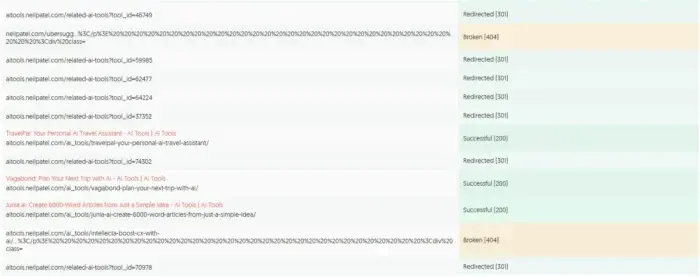
Ubersuggest’s Site Audit feature checks every link on your site. If one shows a 404 error, it will appear in the report.
Fixing existing 404 errors on your site is great, but the real link building begins when you look at other people’s broken backlinks.
Enter a competitor’s URL into tools like Ahrefs’s Site Explorer, filter by “404 not found,” and look at pages with links pointing to them. If you have relevant content (or can quickly create it), pitch it as a replacement.
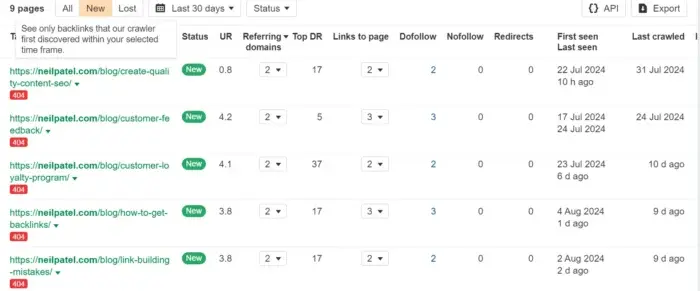
This works especially well on resource pages, like blog posts or directories full of helpful tools, guides, or statistics. If they’re linking to a dead page, it’s a great opportunity to slide in with a recommended replacement. And while not every broken link will be worth your time, high-authority domains or pages with multiple backlinks can lead to serious SEO upside.
Not every broken link is worth chasing. You want links from high-authority, relevant domains; the kinds of pages that still get traffic and offer clear value to your niche. Before you do anything else, assess the referring page. Does it make sense for your content to be there, and does it align with your expertise? Use tools to get a snapshot of the page’s authority and backlink profile. If the referring domain is weak or spammy, move on.
Understand why the original content earned the link. Maybe it had a compelling statistic or offered a unique resource. Knowing what made it link-worthy helps you create something that meets the same need or improves on it. A good match makes your replacement more natural and incentivizes the site owner to update it.
Wikipedia is a top-ranking site because it’s a great source of info about almost any topic, but it’s a goldmine for broken link building (if you do it ethically, focusing on where you can provide value versus spamming your links). Some pages can suffer from link rot, where pages lose citations because the links are dead. This is your opening, but you have to be careful about how you pitch it.
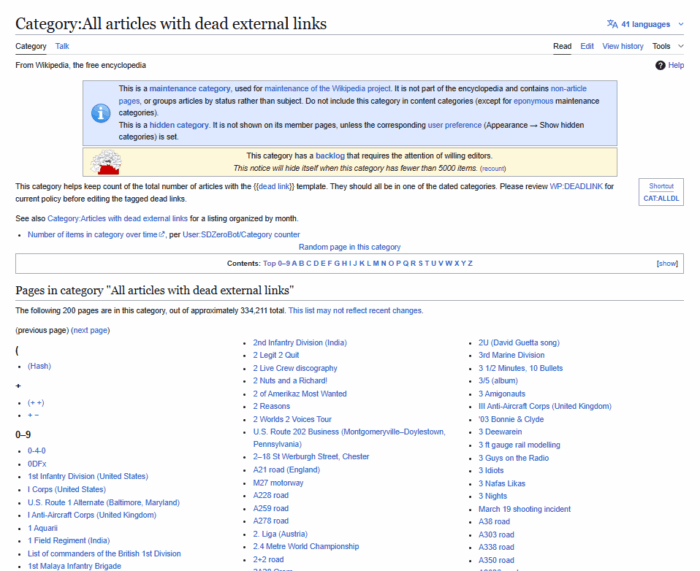
Use a simple search like site:wikipedia.org [your topic] “dead link” to find relevant articles. Scroll down to references and look for those marked as inactive. Check the original content using the Wayback Machine to see what it covered. If you have something that covers the same topic (although more updated or in-depth), you might try to submit it as a replacement.
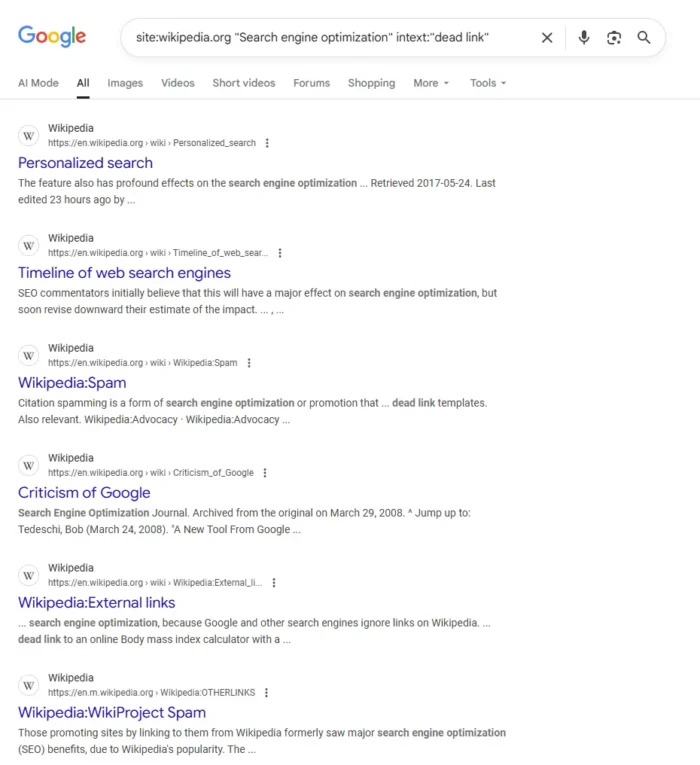
Wikipedia links are nofollow, so they can’t pass SEO authority directly. But the value comes from visibility and second-tier links. When other sites reference Wikipedia, they may follow your citation. But don’t just rush in and start dropping links. Credibility is important, and you can build it by making non-promotional edits. Quality counts, and it’s better to play the long game.
Sometimes it’s tough to convince site owners to link directly to your site. Guest content can help. Instead of asking them to link to your blog, create an article (a guest post) on a respected third-party site that covers the same topic as the dead resource. Once it’s live, you can suggest that article as the replacement.
Let’s say you find dozens of links pointing to a now-defunct “Beginner’s Guide to Content Marketing.” Instead of pitching your own blog post, you can write a fresh guide for a trusted publisher like Entrepreneur or HubSpot. When you reach out to webmasters still linking to the broken page, you point them to your new article as a reliable alternative. But because it’s already on an existing third-party site, it feels better to them.
This approach works because it’s often less promotional and it gives the site master a credible replacement. At the same time, you benefit from the visibility and authority of the site hosting your guest content.
When a site goes offline or a domain expires, links pointing to it don’t disappear. They break. That’s where opportunity lives. Find expired domains in your niche that once hosted valuable content and pitch your own work as a replacement. Use a tool like ExpiredDomains.net to search for specific keywords and filter for those with strong backlink profiles. Analyze which pages had the most links using the tools listed above. If they still exist but point to dead content, you now have a target list.
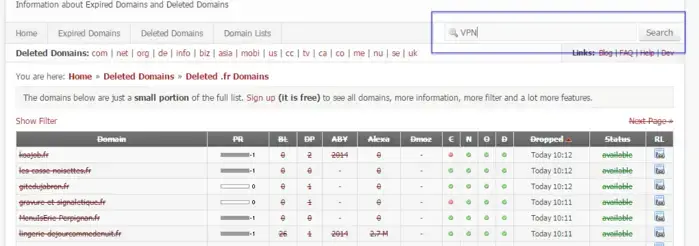
Reach out to sites still linking and offer your content as a replacement, especially if you have statistics. It’s a great fit when the original resource was widely referenced or lived on a highly trusted site. Just make sure your content delivers comparable or better value, because no one wants to swap in a low-effort piece for something readers once relied on.
Sometimes link opportunities exist, but your content doesn’t. Start by reviewing a broken page using the Wayback Machine. What was the topic, and what made it valuable? Seek signs that it offered original data or research that earned its authority or trust in its time.
Once you know what it delivered, consider how to improve it. Your goal isn’t to copy, but to provide updated details or a more modern take. Even improving the UX can help replace the original.
The best replacement content emphasizes clarity and usefulness, such as comprehensive guides or data-driven posts accompanied by visual resources. Things that help solve problems are great, too. When you’re ready to reach out, you’ll have a pitch-ready link that genuinely benefits the site owner and their audience.
Outreach is where most broken link building efforts fall apart. You’ve done the research and found strong opportunities. But if your email reads like spam, you’re done.
Take time to identify the right person to contact. Use LinkedIn, the site’s “About” page, or email tools to find the editor, webmaster, or content manager. Don’t just send it to a generic inbox. Keep your message short and direct. Don’t bury the ask under fluff. Let them know you came across the article, noticed a broken link, and thought your content might be a good replacement.
Tone matters. Avoid sounding like a sales pitch. Be helpful, polite, and clear about what you’re offering. Mention the original content’s value and explain why your piece fits just as well (or better, if applicable).
If you don’t get a reply, wait a few days and send a short follow-up. No pressure, just a reminder. Most importantly, keep things human. The goal isn’t a backlink by itself, but a relationship that can pay off in the long term.
Broken link building starts with finding links that point to dead pages. Once you have a list, you contact the site owners and suggest your content as a replacement. The key is making sure your content matches the intent of the original resource, whether that’s a guide, a statistic, or a tool. Done well, it helps the site fix a bad user experience while earning you a backlink.
Broken link building boosts SEO by fixing broken links, improving The simplest way is to use SEO tools. Platforms like Ubersuggest, Ahrefs, Semrush, or Screaming Frog can scan websites for 404 pages. You can run your own site to identify lost opportunities or analyze competitor domains to uncover broken backlinks that you could replace. Resource pages are another great place to look, since they often include multiple links; over time, some will go bad.
Broken link building is an off-page SEO strategy where you recover or earn backlinks by replacing dead links with your own content. Search engines reward sites that earn quality backlinks, so turning broken links into live ones helps improve authority, trust, and rankings. It’s a win for both sides: the site owner fixes a broken resource, and you gain a link that strengthens your SEO.
Broken link building fixes errors on other sites, but the bigger picture is that it turns missed opportunities into lasting SEO gains, especially in a world of search everywhere optimization. When you find broken backlinks and create or repurpose valuable content to replace them, you can earn links that improve your rankings and credibility.
But the real power is that it scales. When you reclaim lost links on your site or uncover gaps in competitor content, each replacement adds authority to your brand. Combine it with smart digital PR strategies and thoughtful internal linking, and you can see compounding results over time.
Like any SEO strategy, it takes patience. But when done well, broken link building can become one of the most effective (and sustainable) ways to grow your SEO footprint.
Continue reading...
Do you ever feel like you’re doing all the right things for SEO, but not seeing the organic traffic you deserve?
There’s a strategy out there you may not have considered. It flies under the radar but can still land you high-authority backlinks without creating brand new content: broken link building.
There are thousands of broken backlinks out there that point to dead pages. It’s wasted link equity waiting for someone to claim it. Why shouldn’t that be you?
In this guide, I’ll show you exactly where and how to find broken links, pitch your content as a replacement, and boost your rankings and domain authority with content you’ve already written or made. It’s a low-effort, high-upside link strategy worth your time.
Key Takeaways
- Broken link building turns dead links into SEO wins. By replacing broken backlinks with your own content, you help site owners improve user experience while earning high-authority links for yourself.
- Links go bad all the time. Pages get deleted, site structures change, URLs are mistyped, and entire domains shut down. Each of those creates an opportunity for you to step in with a better resource.
- The best opportunities come from competitors and resource pages. Tools like Ubersuggest, Ahrefs, Semrush, and Screaming Frog make it easy to spot broken backlinks you can target.
- Quality matters more than volume. Focus on authoritative, relevant domains and create content that matches or improves on the original resource. That’s what makes webmasters willing to update their links.
- Outreach is the make-or-break step. Keep your communication short, helpful, and human. Finding the right contact and offering real value is what turns a cold email into a lasting relationship.
What Is Broken Link Building and Why Is It Useful?
Broken link building is finding dead links on other sites and suggesting your content as a replacement. It’s one of the smartest ways to build high-quality backlinks without creating content from scratch. You can reap the benefits by earning a link because you’re helping site owners fix their user experience issues.
Links can go bad for a variety of reasons. Maybe the original page was deleted, or a website changed its site structure. Sometimes, the URL might be wrong, or the domain ceases to exist completely. Whatever the cause, a broken link equals a poor user experience (and lost SEO value).
That’s where you come in.
Fixing these links by offering relevant, helpful content improves the referring site’s authority and boosts your rankings and traffic. It’s a win-win opportunity and a solid addition to any internal linking or domain authority growth strategy.
But how do you find these broken links, anyway? And what should you do to contact site owners about this problem?
How To Find Broken Links
There are two sides to finding a broken backlink opportunity:
- Broken links on your site.
- Broken links on other sites you can replace.
Before you look elsewhere, it’s worth checking your site for broken inbound or outbound backlinks. Tools like Ubersuggest, Screaming Frog, Ahrefs, and Semrush can scan for 404 errors across your site’s pages. Look for:
- Inbound links pointed to deleted pages
- Outbound links that lead to dead URLs

Ubersuggest’s Site Audit feature checks every link on your site. If one shows a 404 error, it will appear in the report.
Fixing existing 404 errors on your site is great, but the real link building begins when you look at other people’s broken backlinks.
Enter a competitor’s URL into tools like Ahrefs’s Site Explorer, filter by “404 not found,” and look at pages with links pointing to them. If you have relevant content (or can quickly create it), pitch it as a replacement.

This works especially well on resource pages, like blog posts or directories full of helpful tools, guides, or statistics. If they’re linking to a dead page, it’s a great opportunity to slide in with a recommended replacement. And while not every broken link will be worth your time, high-authority domains or pages with multiple backlinks can lead to serious SEO upside.
Broken Link Building Best Practices
Review Link Prospects
Not every broken link is worth chasing. You want links from high-authority, relevant domains; the kinds of pages that still get traffic and offer clear value to your niche. Before you do anything else, assess the referring page. Does it make sense for your content to be there, and does it align with your expertise? Use tools to get a snapshot of the page’s authority and backlink profile. If the referring domain is weak or spammy, move on.
Understand why the original content earned the link. Maybe it had a compelling statistic or offered a unique resource. Knowing what made it link-worthy helps you create something that meets the same need or improves on it. A good match makes your replacement more natural and incentivizes the site owner to update it.
Wikipedia Dead Link Technique
Wikipedia is a top-ranking site because it’s a great source of info about almost any topic, but it’s a goldmine for broken link building (if you do it ethically, focusing on where you can provide value versus spamming your links). Some pages can suffer from link rot, where pages lose citations because the links are dead. This is your opening, but you have to be careful about how you pitch it.

Use a simple search like site:wikipedia.org [your topic] “dead link” to find relevant articles. Scroll down to references and look for those marked as inactive. Check the original content using the Wayback Machine to see what it covered. If you have something that covers the same topic (although more updated or in-depth), you might try to submit it as a replacement.

Wikipedia links are nofollow, so they can’t pass SEO authority directly. But the value comes from visibility and second-tier links. When other sites reference Wikipedia, they may follow your citation. But don’t just rush in and start dropping links. Credibility is important, and you can build it by making non-promotional edits. Quality counts, and it’s better to play the long game.
Using Guest Content to Replace Broken Links
Sometimes it’s tough to convince site owners to link directly to your site. Guest content can help. Instead of asking them to link to your blog, create an article (a guest post) on a respected third-party site that covers the same topic as the dead resource. Once it’s live, you can suggest that article as the replacement.
Let’s say you find dozens of links pointing to a now-defunct “Beginner’s Guide to Content Marketing.” Instead of pitching your own blog post, you can write a fresh guide for a trusted publisher like Entrepreneur or HubSpot. When you reach out to webmasters still linking to the broken page, you point them to your new article as a reliable alternative. But because it’s already on an existing third-party site, it feels better to them.
This approach works because it’s often less promotional and it gives the site master a credible replacement. At the same time, you benefit from the visibility and authority of the site hosting your guest content.
Using Expired Domains To Find Opportunities
When a site goes offline or a domain expires, links pointing to it don’t disappear. They break. That’s where opportunity lives. Find expired domains in your niche that once hosted valuable content and pitch your own work as a replacement. Use a tool like ExpiredDomains.net to search for specific keywords and filter for those with strong backlink profiles. Analyze which pages had the most links using the tools listed above. If they still exist but point to dead content, you now have a target list.

Reach out to sites still linking and offer your content as a replacement, especially if you have statistics. It’s a great fit when the original resource was widely referenced or lived on a highly trusted site. Just make sure your content delivers comparable or better value, because no one wants to swap in a low-effort piece for something readers once relied on.
Create Replacement Content
Sometimes link opportunities exist, but your content doesn’t. Start by reviewing a broken page using the Wayback Machine. What was the topic, and what made it valuable? Seek signs that it offered original data or research that earned its authority or trust in its time.
Once you know what it delivered, consider how to improve it. Your goal isn’t to copy, but to provide updated details or a more modern take. Even improving the UX can help replace the original.
The best replacement content emphasizes clarity and usefulness, such as comprehensive guides or data-driven posts accompanied by visual resources. Things that help solve problems are great, too. When you’re ready to reach out, you’ll have a pitch-ready link that genuinely benefits the site owner and their audience.
Refining Your Broken Link Building Outreach
Outreach is where most broken link building efforts fall apart. You’ve done the research and found strong opportunities. But if your email reads like spam, you’re done.
Take time to identify the right person to contact. Use LinkedIn, the site’s “About” page, or email tools to find the editor, webmaster, or content manager. Don’t just send it to a generic inbox. Keep your message short and direct. Don’t bury the ask under fluff. Let them know you came across the article, noticed a broken link, and thought your content might be a good replacement.
Tone matters. Avoid sounding like a sales pitch. Be helpful, polite, and clear about what you’re offering. Mention the original content’s value and explain why your piece fits just as well (or better, if applicable).
If you don’t get a reply, wait a few days and send a short follow-up. No pressure, just a reminder. Most importantly, keep things human. The goal isn’t a backlink by itself, but a relationship that can pay off in the long term.
FAQs
How do you do broken link building?
Broken link building starts with finding links that point to dead pages. Once you have a list, you contact the site owners and suggest your content as a replacement. The key is making sure your content matches the intent of the original resource, whether that’s a guide, a statistic, or a tool. Done well, it helps the site fix a bad user experience while earning you a backlink.
How do I find broken links for link building?
Broken link building boosts SEO by fixing broken links, improving The simplest way is to use SEO tools. Platforms like Ubersuggest, Ahrefs, Semrush, or Screaming Frog can scan websites for 404 pages. You can run your own site to identify lost opportunities or analyze competitor domains to uncover broken backlinks that you could replace. Resource pages are another great place to look, since they often include multiple links; over time, some will go bad.
What is broken link building in SEO?
Broken link building is an off-page SEO strategy where you recover or earn backlinks by replacing dead links with your own content. Search engines reward sites that earn quality backlinks, so turning broken links into live ones helps improve authority, trust, and rankings. It’s a win for both sides: the site owner fixes a broken resource, and you gain a link that strengthens your SEO.
Conclusion
Broken link building fixes errors on other sites, but the bigger picture is that it turns missed opportunities into lasting SEO gains, especially in a world of search everywhere optimization. When you find broken backlinks and create or repurpose valuable content to replace them, you can earn links that improve your rankings and credibility.
But the real power is that it scales. When you reclaim lost links on your site or uncover gaps in competitor content, each replacement adds authority to your brand. Combine it with smart digital PR strategies and thoughtful internal linking, and you can see compounding results over time.
Like any SEO strategy, it takes patience. But when done well, broken link building can become one of the most effective (and sustainable) ways to grow your SEO footprint.
Continue reading...